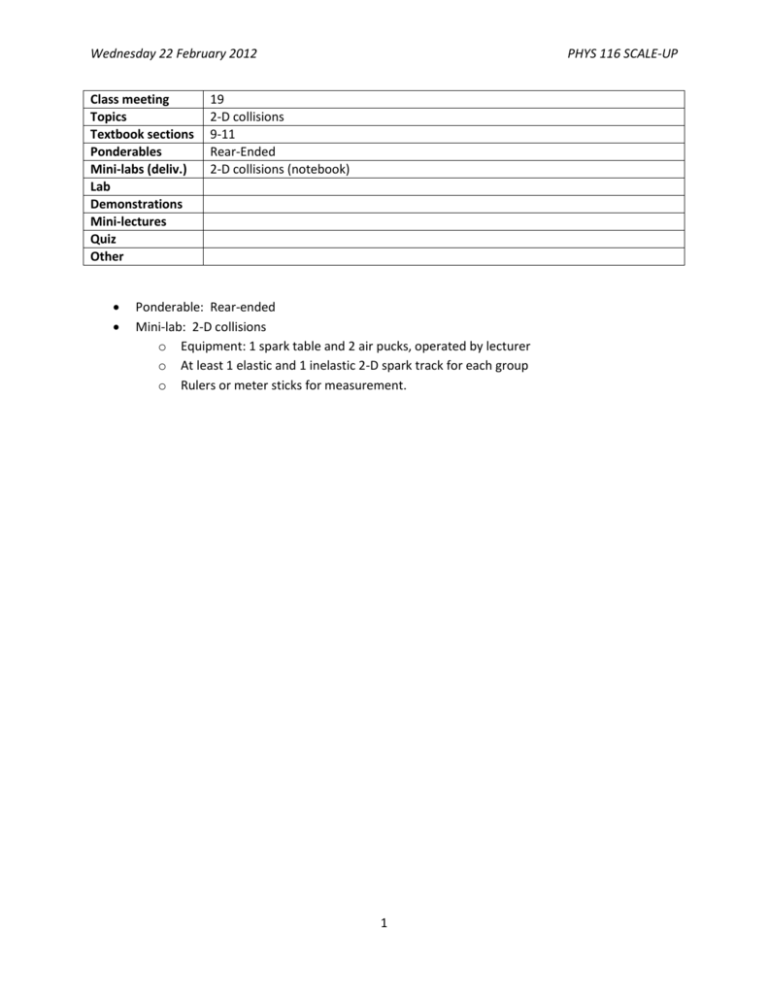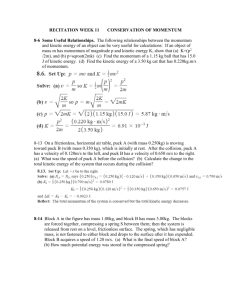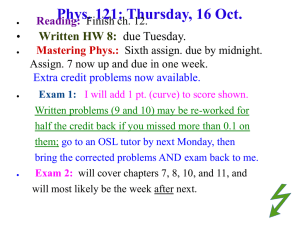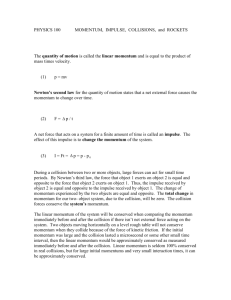class19_S2012_final
advertisement

Wednesday 22 February 2012 Class meeting Topics Textbook sections Ponderables Mini-labs (deliv.) Lab Demonstrations Mini-lectures Quiz Other PHYS 116 SCALE-UP 19 2-D collisions 9-11 Rear-Ended 2-D collisions (notebook) Ponderable: Rear-ended Mini-lab: 2-D collisions o Equipment: 1 spark table and 2 air pucks, operated by lecturer o At least 1 elastic and 1 inelastic 2-D spark track for each group o Rulers or meter sticks for measurement. 1 Wednesday 22 February 2012 PHYS 116 SCALE-UP REAR-ENDED To earn extra money while at Carolina, you form an accident-reconstruction team with your classmates. Your first job is to analyze an accident for the Chapel Hill Police Department. A careless driver rearended a car that was halted at a stop sign. Just before impact, the driver slammed on his brakes, locking the wheels. The driver of the struck car had his foot solidly on the brake pedal, locking his brakes. The mass of the struck car was 900 kg, and that of the initially moving vehicle was 1200 kg. On collision, the bumpers of the two cars meshed. You go out to the crash site and determine from the skid marks that after the collision the two cars moved 0.76 m together. You also run a few experiments and conclude that the coefficient of kinetic friction between the tires and pavement was 0.92 on the day of the accident. The driver of the moving car claims that he was traveling at less than 15 km/hr as he approached the intersection. Is he telling the truth? 2 Wednesday 22 February 2012 PHYS 116 SCALE-UP 2-D COLLISIONS Background. Consider two objects with masses m1 and m2 that undergo a glancing collision, one in which neither mass rebounds in a direction opposite to its initial path. To visualize such a collision, see the figure to the lower right. Somewhere near the actual collision, a line can be drawn in an arbitrary direction from which all the angles are measured. Call this line the x-axis. The angle that the initial (before the collision) path of mass 1 makes with the x-axis is labeled θ1i and the angle that its final (after the collision) path makes is θ1f. Similar notations are used for the angles of the initial and final paths of mass 2. According to the principle of conservation of momentum, the momentum of the system will not change as a result of the collision. To illustrate this idea, suppose the two objects in the above figure rebound off one another and, subsequent to the collision, move apart. When the momenta of each of the two objects have changed, we say that the objects have exchanged momentum with each other. To analyze the collision in the figure, split up the initial momentum vectors into their components along the x-axis and the y-axis: Px,i P1x,i P2 x,i m1v1i cos1i m2 v2i cos 2i Py,i P1y,i P2 y,i m1v1i sin 1i m2 v2i sin 2i Do the same for the final momentum vectors, keeping in mind the velocity is taken as positive if the object is moving to the right (in the direction you arbitrarily assign as the positive x direction) or the object is moving upwards (in the direction that you arbitrarily assign as the positive y-axis). The sign of the velocity will indicate the sign of each term in the expression for momentum. Conservation of momentum requires that Px,i = Px,f and Py,i = Py,f and therefore also that the total momentum vector, Ptotal , defined by applying the rules of vector addition, is conserved as well: Ptotal,i = Ptotal, f Ptotal = Px2 + Py2 tanqtotal = 3 Py Px Wednesday 22 February 2012 PHYS 116 SCALE-UP If no net work is done during the collision, the collision is said to be elastic, and the kinetic energy is conserved. For the above example as an elastic collision, the kinetic energy must satisfy: KEi 1 1 m1v1i2 m2 v2i2 m1v12f m2 v22 f KE f 2 2 If kinetic energy is lost during the collision (i.e. net work is done on the system), the collision is said to be inelastic. A diagram of one possible inelastic case, in which the two objects stick together after the collision (in which case the collision is said to be totally inelastic) is shown to the right: It is important to note that momentum is conserved in both elastic and inelastic collisions. Prelab Deliverable (to be submitted on Sakai before class): For equal masses colliding, fill out the missing parts of this table: initial final P1 mv P2 mv P1x P1y P2x P2y -√3mv/2 mv/2 mv/√2 mv/√2 Does it describe an elastic or an inelastic collision? 4 θ1 45° θ2 30° Wednesday 22 February 2012 PHYS 116 SCALE-UP Exploration. For this exercise you will be provided with records of collisions that took place between pucks on an air table (the air cushion minimizes extraneous effects such as friction that can interfere with the momentum conservation measurement). As you will see in the demonstration preceding the lab exercise, a visible record of the motion of the pucks will be made by creating a spark from the puck to the air table through a piece of recording paper and carbon paper which have been set on top of the air table. You will be given sheets of recording paper from this apparatus, containing records of one or more two-dimensional collisions. Disks moving across the paper will have left marks at equal time intervals, so that you are able to determine the speed and trajectory of each disk before and after they collide. Find the initial speed of each puck just before the collision by measuring the distance between successive dots near the collision area and dividing by the spark time interval. As you do this, examine the spacing of the dots. If the spacing is not uniform, what can you conclude about the speed and the assumptions made for this experiment? Define a set of x and y axes on the paper and compute your best estimate of the initial velocity (magnitude and direction) for each puck, along with an estimate of the uncertainty. Record these values in your lab notebook, and use them to calculate the initial momentum and initial kinetic energy for each puck. From these values, determine the initial momentum and kinetic energy of the two-puck system. What is the velocity of the center-of-mass of the two-puck system immediately before the collision? Find the final velocity, momentum and kinetic energy for each puck in a similar fashion. Make your velocity measurements as close in time to the collision as possible (consider why this is important). Use those values to determine the final momentum and kinetic energy of the twopuck system. What is the velocity of the center of mass of the two-puck system immediately after the collision? Was the collision elastic or inelastic? If kinetic energy is not conserved, can you account for the missing kinetic energy? All of your measurements and calculations (as well as the solutions to the applications below) should be recorded in your laboratory notebooks. 5 Wednesday 22 February 2012 PHYS 116 SCALE-UP Applications 1. An alpha particle (helium nucleus) and an oxygen nucleus (both initially in motion) collide headon. The alpha particle is scattered at an angle θ1 = 64.0° relative to its initial direction of travel. The oxygen nucleus recoils at an angle θ2 = 51.0° with a speed 1.20 x 105 m/s. What are the initial and final speeds of the alpha particle? 2. Two particles P (0.10 kg) and Q (0.30 kg) are released from rest 1.0 m apart. P and Q attract each other with a constant force of 1.0 x 102 N, and no external forces act on the two particles. When the separation of the two particles is half of its initial value, what is the speed of the center of mass of the two-particle system? At what distance from the initial position of P do the two particles collide? 6









